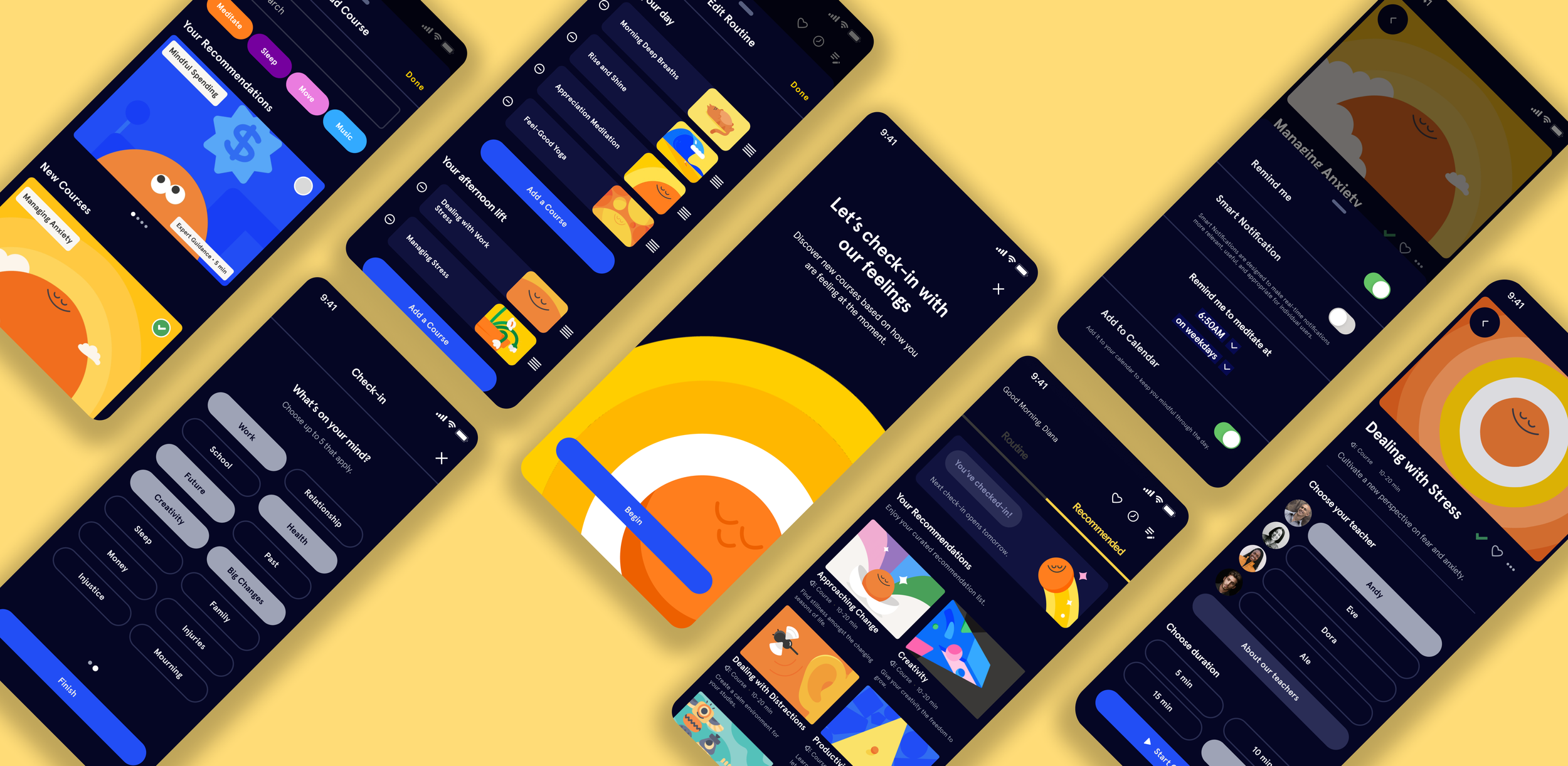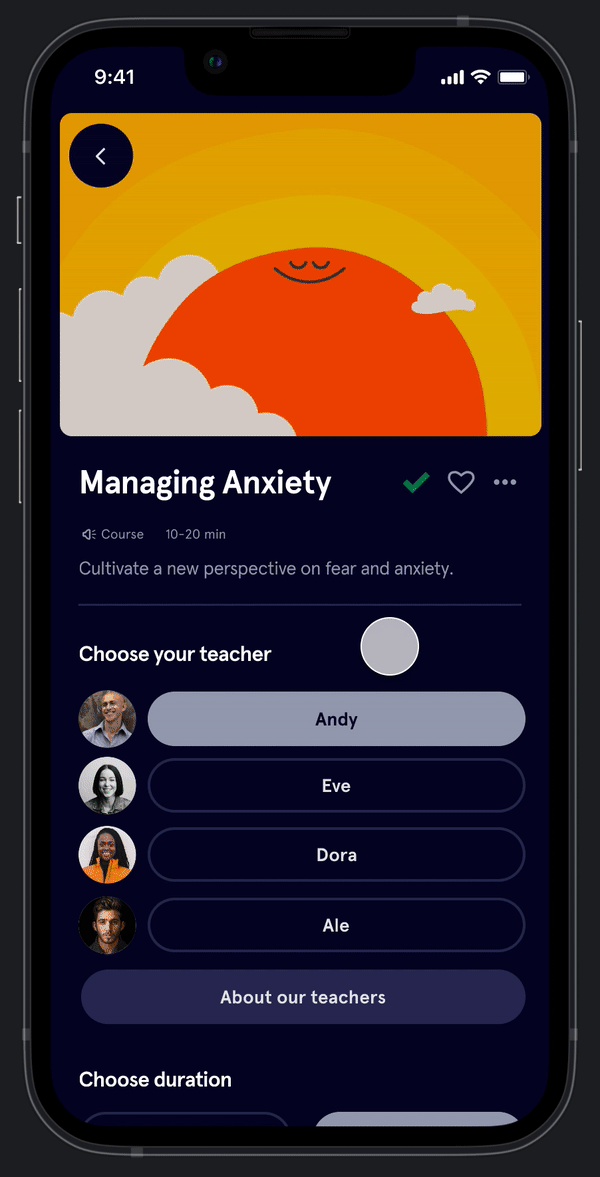Headspace
Developing new features to help users manage staying on track with their meditation efforts

BACKGROUND
Headspace is a popular meditation app with over 70 million users worldwide. The app offers a variety of guided meditations and mindfulness exercises aimed at reducing stress, improving sleep, and increasing overall well-being. While many users have found the app to be helpful, some have reported difficulty in maintaining a consistent meditation practice.
My goal in the project was to uncover what Headspace users want most out of their meditation app to make the experience more useful and meaningful to them. Using those insights, I proposed and integrated four new features to the app while maintaining the UI design and consistency of the Headspace brand. (Conceptual project)
TIMELINE
5 Weeks
(80 Hours)
MY ROLE
UX Designer
(Solo)
TOOLS
Figma/FigJam, Miro, Optimal Workshop, Maze
TASKS
User Research, UI Design, Prototyping, Usability Testing
THE PROBLEM
Despite the ease of use of Headspace, many users struggle to build a consistent meditation practice.
One of the key barriers that users face is a lack of time and competing priorities that make it challenging to find the time and motivation to meditate regularly. There are also some users who feel that the Headspace app offers a “one size fits all” approach and the experience is not tailored to their individual needs and preferences.
How might we help Headspace users overcome the barriers that prevent them from making meditation a consistent habit?
THE SOLUTION
Tailor the Headspace experience to users’ unique needs and goals with all-new personalization features.
These new features are designed to help users establish a daily meditation routine that sticks and create a customized practice that fits seamlessly into their life.
Routine for mindfulness and mental health
With personalized timelines, users have more control of the courses they take and can create a routine for their specific mental health needs—helping users stay engaged and feel more invested in their meditation practice.
Find courses that suit your unique situation
The unique situations and demands of our daily life can dictate what type of self-care we might need the most. With the Check-in feature, you tell Headspace your worries and concerns, and the app will suggest courses aimed at helping you overcome them.
Decide on any amount of time to meditate
Whether you have five minutes or fifty, we have you covered. Providing users with short, on-the-go meditations that can be completed during breaks or downtime throughout the day.
Add personalized reminders for your favorite courses
Users can now set reminders for specific courses, making it more convenient for them to incorporate their meditation practice into their busy schedules. With just a few taps, users can effortlessly jump into their meditation within seconds of receiving the reminder.
DISCOVERY
Landscape Analysis
One of the business problems Headspace has is its intense competition in the meditation app market. With the growing popularity of meditation and mindfulness practices, several other apps, such as Calm and Insight Timer are all competing for users' attention and loyalty.
Here are a few of my keynotes:
User Interviews + Surveys
As someone who uses the Headspace app on a daily basis, I had already formed some ideas about how the app could be improved to enhance the user experience. To validate my assumptions and get a better understanding of other users’ perspectives on the Headspace experience, as well as collect insights on users’ meditation practices and behaviors, I conducted user surveys.
I learned that 50% of users typically meditate for less than 10 minutes, but the Headspace app has few meditation sessions under 10 minutes.
I also conducted 5 user interviews focused on understanding users' motivations and barriers to daily meditation practice.
User interviews revealed insights on the importance of personalized experiences, flexible meditation durations, and common barriers to consistent practice, such as lack of time and motivation.
DEFINE
Emphasizing with Users 🧘♀️
I developed a user persona that embodies the feedback and opinions shared by actual Headspace users in my interviews and survey responses. Consistently referencing this persona throughout the design process ensured my solutions aligned with users’ core needs and effectively addressed their issues.
Design Challenges
How might we design new Headspace features to address the specific needs and challenges of different users?
How might we personalize the Headspace experience to help users create a meditation routine that fits their unique lifestyle and schedule?
How might we streamline the process of discovering new content that feels tailored to the user?
IDEATE
Designing for user needs
Using the insights I gathered from my research, I developed new features such as personalized timelines, reminders, durations, and a check-in feature that would provide users with greater flexibility, convenience, and customization.
My goal with these features were to help users establish and maintain a consistent meditation habit—regardless of their busy schedules or level of experience—and help users received course recommendations that feel tailored to their unique circumstances.
Sitemap + User Flows
The new challenge was to map out how the new features would integrate into Headspace's existing product without disrupting its current design patterns. I used a sitemap to identify new screens that would be added for the features.
Most notable change was the addition of the Recommendation tab, which would house both the new check in feature and personalized course recommendations for each user.
I created a series of user flows that took into account the various decisions and actions they may take while completing tasks. This helped to highlight the different interactions, screens, and entry/exit points that users may encounter while using the product.
User flow: User wants to add a course to their morning routine
DESIGN
Early Sketches & Wireframes
Starting my designing process with sketches would also allow me to explore several alternatives quickly for choosing the direction of the new features. I adopted patterns and elements that are consistent with what already exists and that users are already familiar with within the Headspace app.
Throughout the project, I continued to gather user feedback to identify areas for improvement and refine the features over time.
Early sketches
Early Iteration Key Screens
v1 A/B Testing
Mid-Fidelity User Flow
v3 User Flows
Duration Feature Exploration
Personalized Routines Feature Exploration 🧘♂️💭
My aim with this feature was to offer users a customized meditation experience that minimizes decision fatigue and enables them to discover and engage with content that aligns with their interests and needs.
To achieve this, I enable users to add courses to their homepage through either the new "Routine" settings or directly from the meditation course. Additionally, I made sure that users could easily modify their routine whenever necessary by making the routine settings easily accessible from the home screen.
Check-in Feature Exploration 🧘♂️💭
For this feature, I prioritized simplicity and clarity. I focused on having a clean and straightforward user flow with clear and concise instructions to ensure the entire process of finding the right course for users’ meditation needs is as simple and intuitive as possible.
Users just simply answer a few questions as to how they’re feeling and based on their responses, the app would recommend a few meditation courses that fit their current needs or mood.
USER TESTING
Feedback validated design direction
I conducted usability tests with 5 regular Headspace users to ensure the new features would make sense to them and see if various tasks related to those new features could be completed. Research findings were 100% of users were able to successfully complete the given tasks and a 96% task error-free rate with few minor revisions.
FINAL DESIGN
Key Features Overview
Like any new habit, the toughest part is always sticking with it so I’ve designed some new features to make it a bit easier. Here’s a look at how these features would personalize the Headspace experience and help users in making meditation a part of their regular routine.
CONCLUSION
Reflecting on Headspace
Designing for a mental health app requires a deep understanding of users' needs and motivations. Through extensive user research, I discovered that personalization and flexibility were essential factors in creating a more engaging and effective meditation app.
Designing for mindfulness is not just about aesthetics, but about creating a tool that truly helps people improve their well-being and quality of life. During this project, I drew inspiration from other successful apps such as Duolingo and ClassPass to explore different solutions that could help users achieve their goals. Also, working within the limitations of an established product and designing within an existing system was a valuable learning experience. It allowed me to develop my skills in working with design patterns and components and to enhance my eye for detail.
As a designer, it was crucial to align any new feature to the Headspace app with the company’s vision and mission in mind. Ultimately, the goal for this project was to develop new features that not only enhance the user experience but also in helping users to lead happier, healthier lives.











